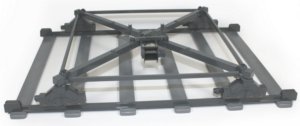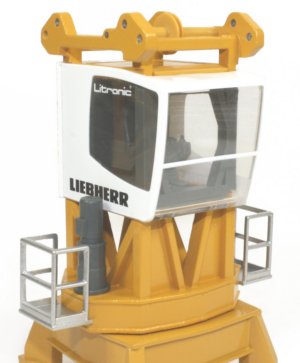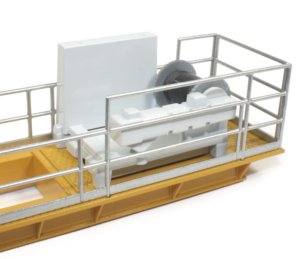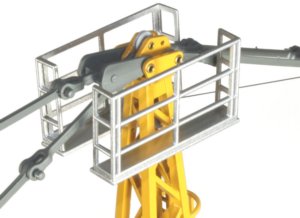
Liebherr 630 EC-H 40 Tower Crane
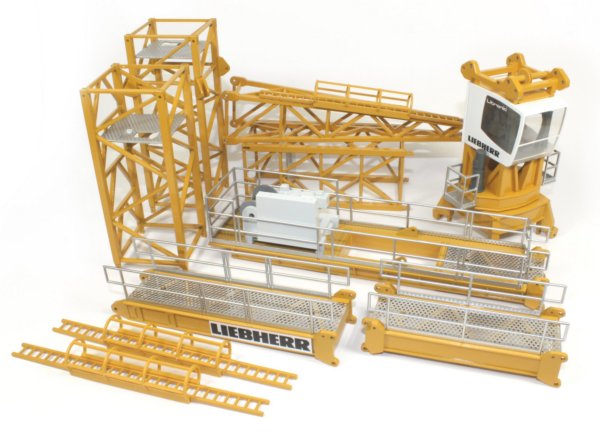
Presented here is the gigantic 1:50th scale Liebherr 630 EC-H 40 tower crane from Conrad. When this model was first announced, it became the largest mass produced 1:50th scale tower crane, following the announcement from TWH that they were producing the Potain MSD192 in 1:50th scale.
|
|
The crane is mounted to a rail track which consists of two metal rails with integrated end stops which fit onto six plastic sleepers.
|
|
The main base of the crane is formed from an X shaped main structure with metal support bars keeping the frame rigid. |
Each corner of the frame has a bogie assembly with four metal rollers which locate with the track. The bogies can swivel to align perfectly with the track and roll smoothly which is good, considering the final weight of the crane sitting on the track base.

The mast sections each have a fitted metal platform with a textured diamond plate texture with an indent and hole where the access ladders fit. The ladders are metal with plastic safety cages clipped in place.
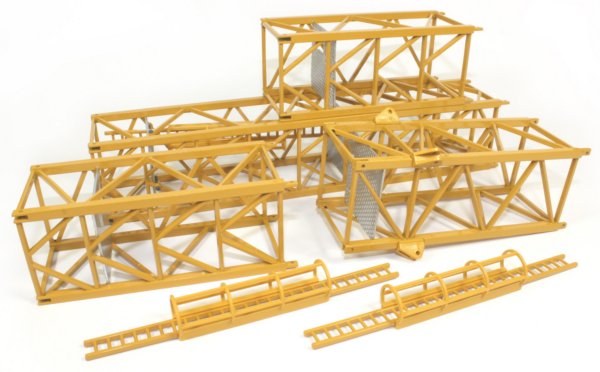
Once the base mast section is fitted to the frame, four upright support bars need to be locked into place to ensure the mast is perfectly vertical and to remove any instability. The masts push-fit into each other with small plastic pins used to secure the masts securely. The fit is tight which allows the mast sections to be constructed true to vertical.

Six large plastic slabs are supplied which simulate the concrete counterweights found on the full sized crane. These rest on the X frame at the base and have dimples cast into the surface keeping them positioned. The Liebherr name is crisply cast into the front surface of each piece for a little extra detail and a specification plate is supplied which clips into position on the first mast.
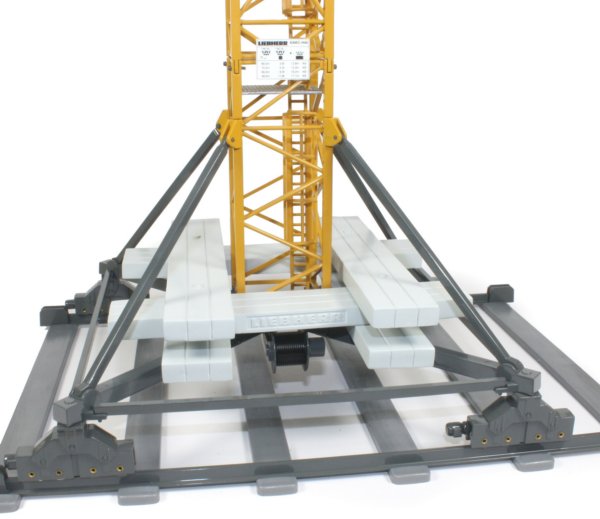
There are a number of parts supplied in the box with counterweight pieces, mast and jib sections, ladders access platforms and the main hook block just some of the parts that need assembling.

The crane is supplied with a non-functional climbing cage which is a nice addition to the model. The climbing frame is an interesting piece of engineering, allowing the crane to grow in height as required by lifting itself up so a new mast section can be installed. The cage on the model features a lower walkway with safety railings around the edges with the main lift cylinder and locking bar replicated. One side of the cage is open to accept the new mast section although the upper access platform usually found on climbing cages has been omitted.

The cab is built around the structural frame which connects the jib and back mast and has been fully replicated on the model with the frame clearly visible through the large glazed windows.
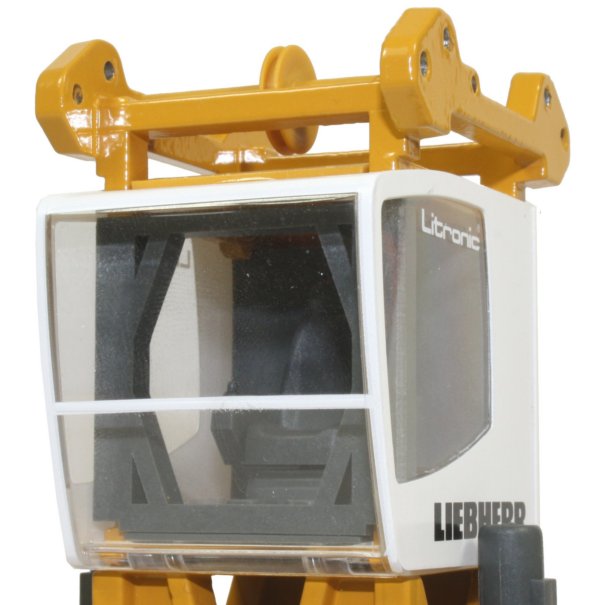
|
|
The cab frame rotates through 360 degrees with small access platforms on each side along with moulded slewing motors which add to the detail level. The rotation is fairly stiff but this is needed to ensure there is no oscillation between the mast and upper crane works which could cause instability. Above the roof of the cab are the connection points for the A section, jib and rear mast which holds the counterweights and main hook winch. The jib is made up of various sections which are connected together with plastic pins. Photo-etched access walkways have been riveted to the lower part of each jib section which is a nice addition. |
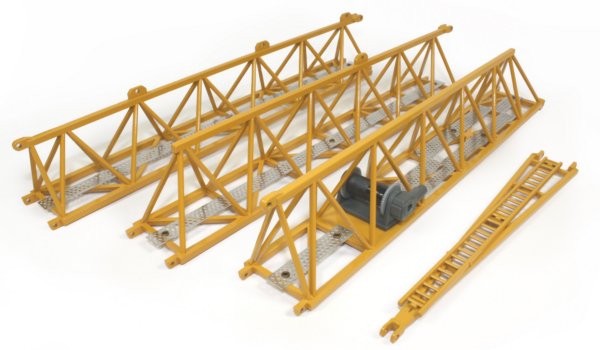
The rear mast sections have metal safety railings and mesh etched walkways which look very good. As with the jib sections, they lock together with the plastic pins and the fit is snug, preventing the sections from drooping. The counterweight pieces are utilised to ensure the model remains sturdy and correctly balanced and these slide into place in the cut-out within the rear frame. The fit is a little loose and there is nothing to keep each segment in place so all the counterweights need to be used to ensure they don't work loose and fall out, and as they are fairly heavy, from nearly 2 metres high, they could cause some damage.
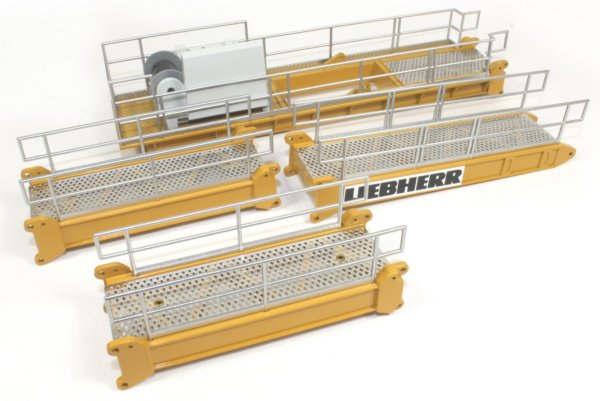
|
The rear-most section houses the main lifting winch which has a control cabinet and ridged, thumb operated drum with pre-rigged rope. |
The main support structure has an access ladder with metal walkways and safety railings |
|
|
When fully rigged, this is an impressive model which requires plenty of space to display correctly. The first revision of the model had a slight droop on the jib which, while fixable, did not look correct so a new version of the model (Reviewed here) has been produced which has a different configuration for the pennant lines that connect the jib and back-mast. These new pennants raise the jib by about 5 degrees from horizontal, matching the angle found on the full sized crane.

|
The collector has the option of fitting either a single hook or double hook block. The hook consists of several parts which are pinned together for the double hook configuration with two trolleys, complete with small riveted plastic rollers which slide along the length of the jib. Unfortunately, the trolley winch, while modeled and fitted to the jib, is not really functional and there are no instructions provided as to how this would work. This is a shame considering the high levels of engineering found elsewhere on the model. |
|
The assembly instructions provided with the model are very good with clear, step by step guides on how to assemble each part of the model The paint finish on the model reviewed here has slight shade differences between some of the yellow parts but this is not really noticeable once erected.


